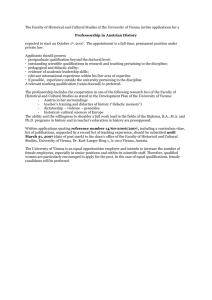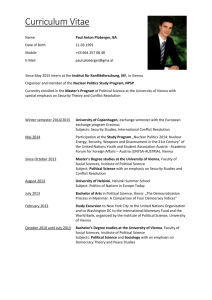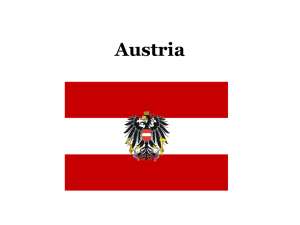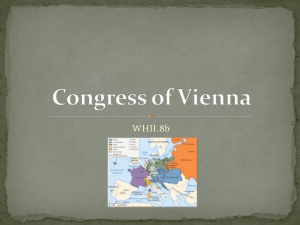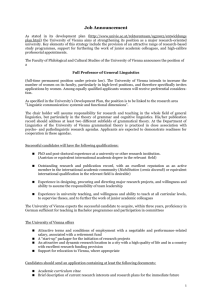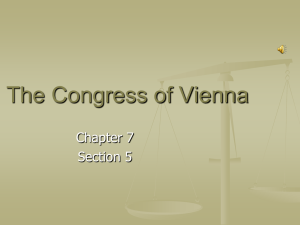Vienna – Facts & Figures - B2B Service for the tourism industry
advertisement
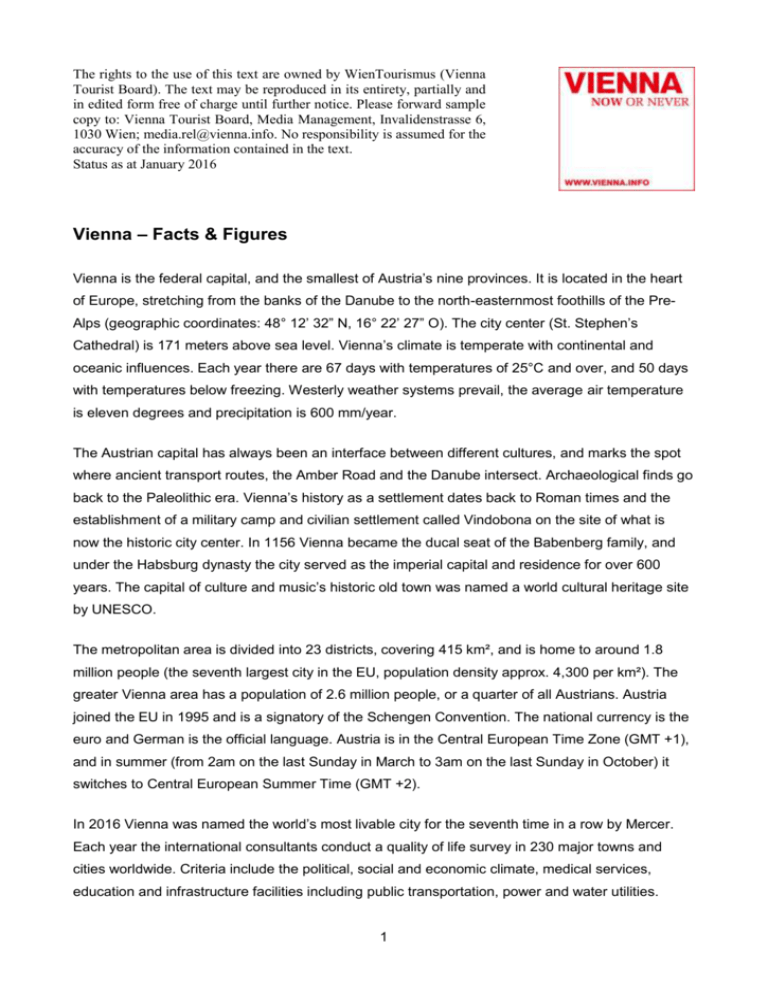
The rights to the use of this text are owned by WienTourismus (Vienna Tourist Board). The text may be reproduced in its entirety, partially and in edited form free of charge until further notice. Please forward sample copy to: Vienna Tourist Board, Media Management, Invalidenstrasse 6, 1030 Wien; media.rel@vienna.info. No responsibility is assumed for the accuracy of the information contained in the text. Status as at January 2016 Vienna – Facts & Figures Vienna is the federal capital, and the smallest of Austria’s nine provinces. It is located in the heart of Europe, stretching from the banks of the Danube to the north-easternmost foothills of the PreAlps (geographic coordinates: 48° 12’ 32” N, 16° 22’ 27” O). The city center (St. Stephen’s Cathedral) is 171 meters above sea level. Vienna’s climate is temperate with continental and oceanic influences. Each year there are 67 days with temperatures of 25°C and over, and 50 days with temperatures below freezing. Westerly weather systems prevail, the average air temperature is eleven degrees and precipitation is 600 mm/year. The Austrian capital has always been an interface between different cultures, and marks the spot where ancient transport routes, the Amber Road and the Danube intersect. Archaeological finds go back to the Paleolithic era. Vienna’s history as a settlement dates back to Roman times and the establishment of a military camp and civilian settlement called Vindobona on the site of what is now the historic city center. In 1156 Vienna became the ducal seat of the Babenberg family, and under the Habsburg dynasty the city served as the imperial capital and residence for over 600 years. The capital of culture and music’s historic old town was named a world cultural heritage site by UNESCO. The metropolitan area is divided into 23 districts, covering 415 km², and is home to around 1.8 million people (the seventh largest city in the EU, population density approx. 4,300 per km²). The greater Vienna area has a population of 2.6 million people, or a quarter of all Austrians. Austria joined the EU in 1995 and is a signatory of the Schengen Convention. The national currency is the euro and German is the official language. Austria is in the Central European Time Zone (GMT +1), and in summer (from 2am on the last Sunday in March to 3am on the last Sunday in October) it switches to Central European Summer Time (GMT +2). In 2016 Vienna was named the world’s most livable city for the seventh time in a row by Mercer. Each year the international consultants conduct a quality of life survey in 230 major towns and cities worldwide. Criteria include the political, social and economic climate, medical services, education and infrastructure facilities including public transportation, power and water utilities. 1 Leisure facilities such as restaurants, theaters, cinemas, sports facilities, availability of consumer goods ranging from food to automobiles, and environmental factors including green space and air quality are also taken into consideration. Half of the city’s total area is accounted for by gardens, parks, woods and agricultural land. 39 percent of all journeys in the city are by public transport – a European record. Vienna is also the only major capital with a significant winegrowing industry within the city limits. Vienna is not just a federal province and capital city, it is also a winegrowing region in its own right, with around 700 hectares of land under vines (about 80 percent white wine varieties). Just 60 kilometers from the Slovak capital Bratislava, Vienna played a leading role in the establishment of the Centrope region in 2003 and the expansion of international transportation links in the area. In 2015 Vienna International Airport reported 22,8 million passengers. Major European trunk routes and interregional rail links all pass through Vienna. The new Hauptbahnhof central railway station is one of the most advanced hubs in the entire trans-European rail network. Vienna is also one of the four UN headquarters cities and the seat of numerous international organizations, including the Organization of the Petroleum Exporting Countries (OPEC), the Organization for Security and Cooperation in Europe (OSCE), the International Atomic Energy Agency (IAEA) and the United Nations Industrial Development Organization (UNIDO). Vienna’s location also makes it the ideal choice as a headquarters for international companies working in Eastern Europe. In 2014 the Vienna Convention Bureau registered 779 international conferences in the Austrian capital. 2014 the International Congress and Convention Association (ICCA) ranked Vienna in second place. 2
